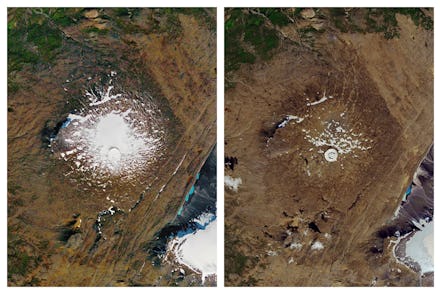Iceland's memorial for a dead glacier offers a terrifying prediction for the future

Just a few years ago, the Okjökull glacier sat proudly atop the volcanic mountain of Ok in Iceland. Now the icy mass is entirely gone and Iceland is honoring the dead glacier in a unique way. In its place now sits a plaque meant to commemorate the first glacier in Iceland to be lost as a result of climate change.
More than 100 people including scientists, politicians and citizens gathered in Iceland for a funeral held for Okjökull. In attendance, according to the BBC: Iceland Prime Minister Katrin Jakobsdottir, Environment Minister Gudmundur Ingi Gudbrandsson and former Irish president Mary Robinson, who also served as the United Nations High Commissioner for Human Rights. The attendees took part in a small ceremony acknowledging Okjökull's nearly 700-year life as a glacier and marked a spot that it once occupied with a plaque. On the monument is a letter to the future, engraved in both English and Icelandic. It reads:
Ok is the first Icelandic glacier to lose its status as glacier. In the next 200 years, all our glaciers are expected to follow the same path. This monument is to acknowledge that we know what is happening and know what needs to be done. Only you know if we did it. August 2019 415ppm CO2
"415ppm CO2" refers to the record level of carbon dioxide in the atmosphere. We passed that mark for the first time in human history in May of this year. As the levels continue to climb, there is expected to be many more environmental victims like Okjökull, as well as potentially devastating effects for humans. A study published in Nature found that between 1961 and 2016, glaciers worldwide have lost over 10 trillion tons of ice — more than enough to cover the 48 contiguous states of the U.S. in four feet of snow. The World Glacier Monitoring Service has warned that glaciers are disappearing five times faster than they were in the 1960s and has predicted that most glaciers won't survive to the year 2100.
Okjökull, like most glaciers around the world, has been shrinking year after year. The once-proud glacier that covered more than 6.2 square miles of land in 1890, according to Sky News, officially lost its glacier status in 2014. At that point, glaciologist Oddur Sigurðsson discovered the snow and ice on the structure was melting at a rate that prevented Okjökull from recuperating what it had lost. At that point, the glacier was no longer thick enough to move by its own weight — one of the requirements for a glacier.
If you have no memory of Okjökull originally being stripped of its glacier title in 2014, that's not much of a surprise. Anthropologists at rice University noted that there was only one instance of news coverage of Okjökull's demise in 2014 and essentially zero international coverage of the event at the time.